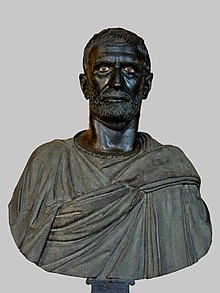
Back Капіталійскі Брут Byelorussian Brutus Capitolí Catalan Kapitolinischer Brutus German Bruto Capitolino Spanish Brutus capitolin French Bruto capitolino Italian Capitolijnse Brutus Dutch Brutus Kapitoliński Polish Капитолийский Брут Russian Kapitolski Brut Slovenian

The Capitoline Brutus is an ancient Roman bronze bust traditionally but probably wrongly thought to be an imagined portrait of the Roman consul Lucius Junius Brutus (d. 509 BC). The bust has long been dated to the late 4th to early 3rd centuries BC, but is perhaps as late as the 2nd century BC,[1] or early 1st century BC.[2]
The bust is 69 cm (27 in) in height and is now in the Hall of the Triumphs within the Capitoline Museums, Rome.[3] Traditionally taken to be an early example of Roman portraiture and perhaps by an Etruscan artist influenced by Hellenistic art and contemporary Greek styles of portraiture, it may be "an archaizing work of the first century BC".[4] The Roman head was provided with a toga-clad bronze bust during the Renaissance.[5]
- ^ Brilliant (2002), p. 55.
- ^ Srong, p 47
- ^ Capitoline Brutus. Musei Capitolini Archived 2016-08-27 at the Wayback Machine. Retrieved August 25, 2016.
- ^ Strong, p. 47
- ^ "Boston Museum of Fine Arts loan exhibition "Visiting Masterpieces: The Capitoline Brutus"". Mfa.org. January 18, 2013.
© MMXXIII Rich X Search. We shall prevail. All rights reserved. Rich X Search